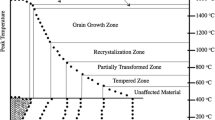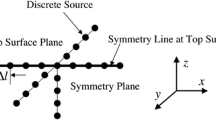Abstract
Inverse thermal analyses of structural steel deep-penetration welds are presented. These analyses employ a methodology that is in terms of numerical-analytical basis functions and constraint conditions for inverse thermal analysis of steady-state energy deposition in plate structures. These analyses provide parametric representations of weld temperature histories that can be adopted as input data to various types of computational procedures, such as those for prediction of solid-state phase transformations and mechanical response. In addition, these parameterized temperature histories can be used for inverse thermal analysis of welds corresponding to other welding processes whose process conditions are within similar regimes. The present study applies an inverse thermal analysis procedure that uses three-dimensional constraint conditions whose two-dimensional projections are mapped within transverse cross sections of experimentally measured solidification boundaries.






















Similar content being viewed by others
References
S. Kou, Welding Metallurgy, 2nd ed., Wiley, New York, 2003, doi:10.1002/0471434027
O. Grong, Materials modelling series, Metallurgical Modelling of Welding, Vol 2, 2nd ed., H.K.D.H. Bhadeshia, Ed., The Institute of Materials, London, 1997, p 1–115
S.V. Patankar, Numerical Heat Transfer and Fluid Flow, Series in Computational Methods in Mechanics and Thermal Sciences, Hemisphere Publishing Corporation, London, 1980
W.H. Press, S.A. Teukolsky, W.T. Vetterling, and B.P. Flannery, Numerical Recipes in Fortran 77, The Art of Scientific Computing, 2nd ed., Volume 1 of Fortran Numerical Recipes Cambridge University Press, New York, 1997
A. Tarantola, Inverse Problem Theory and Methods for Model Parameter Estimation, SIAM, Philadelphia, 2005
C.R. Vogel, Computational Methods for Inverse Problems, SIAM, Philadelphia, 2002
G. Ramm, Inverse Problems, Mathematical and Analytical Techniques with Applications to Engineering, Springer, New York, 2005
J.V. Beck, B. Blackwell, and C.R. St, Clair, Inverse Heat Conduction: III-Posed Problems, Wiley Interscience, New York, 1995
O.M. Alifanov, Inverse Heat Transfer Problems, Springer, New York, 1994
M.N. Ozisik and H.R.B. Orlande, Inverse Heat Transfer, Fundamentals and Applications, Taylor and Francis, New York, 2000
K. Kurpisz and A.J. Nowak, Inverse Thermal Problems, Computational Mechanics Publications, Boston, 1995
J.V. Beck, Inverse problems in heat transfer with application to solidification and welding, Modeling of Casting, Welding and Advanced Solidification Processes, V.M. Rappaz, M.R. Ozgu, and K.W. Mahin, Ed., The Minerals, Metals and Materials Society, Warrendale, 1991, p 427–437
J.V. Beck, Inverse Problems in Heat Transfer, Mathematics of Heat Transfer, G.E. Tupholme and A.S. Wood, Ed., Clarendon Press, Oxford, 1998, p 13–24
A.N. Tikhonov, Inverse Problems in Heat Conduction, J. Eng. Phys., 1975, 29(1), p 816–820
O.M. Alifanov, Solution of an Inverse Problem of Heat-Conduction by Iterative Methods, J. Eng. Phys., 1974, 26(4), p 471–476
O.M. Alifanov and V.Y. Mikhailov, Solution of the Overdetermined Inverse Problem of Thermal Conductivity Involving Inaccurate Data, High Temp., 1985, 23(1), p 112–117
E.A. Artyukhin and A.V. Nenarokomov, Coefficient Inverse Heat Conduction Problem, J. Eng. Phys., 1988, 53, p 1085–1090
T.J. Martin and G.S. Dulikravich, Inverse Determination of Steady Convective Local Heat Transfer Coefficients, ASME J. Heat Transfer, 1998, 120, p 328–334
S.G. Lambrakos and S.G. Michopoulos, Algorithms for Inverse Analysis of Heat Deposition Processes, ‘Mathematical Modelling of Weld Phenomena, Vol 8, Verlag der Technischen Universite Graz, Graz, 2007, p 847
S.W. Smith, The Scientist and Engineer’s Guide to Digital Signal Processing, California Technical Publishing, San Diego, 1997
H.S. Carslaw and J.C. Jaegar, Conduction of Heat in Solids, 2nd ed., Clarendon Press, Oxford, 1959, p 374
R.W. Farebrother, Linear-Least-Square Computations, Marcel Dekker, New York, 1988
Y.B. Bard, Nonlinear Parameter Estimation, Academic Press, New York, 1974
S.G. Lambrakos and J.O. Milewski, Analysis of Welding and Heat Deposition Processes using an Inverse-Problem Approach, Mathematical Modelling of Weld Phenomena, Vol 7, Verlag der Technischen Universite Graz, Graz, 2005, p 1025–1055
S.G. Lambrakos, Inverse Thermal Analysis of 304L Stainless Steel Laser Welds, J. Mater. Eng. And Perform., 2013, 22(8), p 2141
S.G. Lambrakos, Inverse Thermal Analysis of Stainless Steel Deep-Penetration Welds Using Volumetric Constraints, J. Mater. Eng. Perform., 2014, 23(6), p 2219–2232. doi:10.1007/s11665-014-1023-7
S.G. Lambrakos, Inverse Thermal Analysis of Welds Using Multiple Constraints and Relaxed Parameter Optimization, J. Mater. Eng. Perform., 2015, 24(8), p 2925–2936
S.G. Lambrakos, A. Shabaev, and L. Huang, Inverse Thermal Analysis of Titanium GTA Welds Using Multiple Constraints, J. Mater. Eng. Perform., 2015, 24(6), p 2401–2411. doi:10.1007/s11665-015-1511-4
S.G. Lambrakos, A. Shabaev, Temperature Histories of Ti-6Al-4V Pulsed-Mode Laser Welds Calculated Using Multiple Constraints, Naval Research Laboratory Memorandum Report, Naval Research Laboratory, Washington, NRL/MR/6390–15-9621 (2015).
D. Rosenthal, The Theory of Moving Sources of Heat and Its Application to Metal Treatments, Trans. ASME, 1946, 68, p 849–866
J. Goldak, A. Chakravarti, and M. Bibby, A New Finite Element Model for Welding Heat Source, Metall. Trans. B, 1984, 15, p 299–305
R.O. Myhr and O. Grong, Dimensionless Maps for Heat Flow Analyses in Fusion Welding, Acta Metall. Mater., 1990, 38, p 449–460
R.C. Reed and H.K.D.H. Bhadeshia, A Simple Model For Multipass Welds, Acta Metall. Mater., 1994, 42(11), p 3663–3678
V.A. Karkhin, P.N. Homich, and V.G. Michailov, Models for Volume Heat Sources and Functional-Analytic Technique for Calculating the Temperature Fields in Butt Welding, ‘Mathematical Modelling of Weld Phenomena, Vol 8, Verlag der Technischen Universite Graz, Graz, 2007, p 847
A.A. Deshpande, A. Short, W. Sun, D.G. McCartney, L. Xu, and T.H. Hyde, Finite-Element Analysis of Experimentally Identified Parametric Envelopes for Stable Kethole Plasma Arc Welding of a Titanium Alloy, J. Strain Anal. Eng. Des., 2012, 47(5), p 266–275
I.S. Leoveanu, G. Zgura, and D. Birsan, Modeling the Heat and Fluid Flow in the Welded Pool, Bull. Trans. Univ. Brasov, 2007, 3, p 363–368
I.S. Leoveanu, G. Zgura, Modelling the Heat and Fluid Flow in the Welded Pool from High Power Arc Sources, Materials Science Forum, eds. by C. Lee, J-B. Lee, D-H. Park, S-J. Na, vol. 580-582, pp. 443-446, 2008.
E.W. Reutzel, S.M. Kelly, R.P. Martukanitz, M.M. Bugarewicz, P. Michaleris, Laser-GMA Hybrid Welding: Process Monitoring and Thermal Modeling, Trends in Welding Research, Proceedings of the 7th International Conference, eds. by S.A. David, T. DebRoy, J.C. Lippold, H.B. Smartt, J.M. Vitek (ASM International, 2006), pp. 143-148
B.D. Ribic, R. Rai, T.A. Palmer, T. DebRoy, Arc-Laser Interactions and Heat Transfer and Fluid Flow in Hybrid Welding, Trends in Welding Research, Proceedings of the 8th International Conference, eds. by S.A. David, T. DebRoy, J.N. DuPont, T. Koseki, H.B. Smartt, (ASM International, 2009), pp. 313-320
E.A. Metzbower, D.W. Moon, C.R. Feng, S.G. Lambrakos, and R.J. Wong, “Modelling of HSLA-65 GMAW Welds, Mathematical Modelling of Weld Phenomena, 7, Published by Verlag der Technischen Universite Graz, Graz, 2005, p 327–339
Acknowledgment
This work was supported by a Naval Research Laboratory (NRL) internal core program.
Author information
Authors and Affiliations
Corresponding author
Rights and permissions
About this article
Cite this article
Lambrakos, S.G. Inverse Thermal Analysis of Steel Welds Using Solidification-Boundary Constraints. J. of Materi Eng and Perform 25, 2103–2115 (2016). https://doi.org/10.1007/s11665-016-2084-6
Received:
Revised:
Published:
Issue Date:
DOI: https://doi.org/10.1007/s11665-016-2084-6




